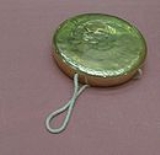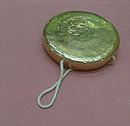
Kkwaenggwari
Encyclopedia
The kkwaenggwari is a small flat gong
used primarily in folk music of Korea
. It is made of brass
and is played with a hard stick. It produces a distinctively high-pitched, metallic tone that breaks into a cymbal
-like crashing timbre
when struck forcefully.
 It is particularly important in samul nori
It is particularly important in samul nori
and pungmul
, although it is also used in other genres.
The instrument's name is probably onomatopoetic for the sound the instrument produces, "kkwaeng-kkwaeng" (hangul: 꽹꽹).
Gong
A gong is an East and South East Asian musical percussion instrument that takes the form of a flat metal disc which is hit with a mallet....
used primarily in folk music of Korea
Korean music
Traditional Korean music includes both the folk, vocal, religious and ritual music styles of the Korean people. Korean music, along with arts, painting, and sculpture has been practiced since prehistoric times....
. It is made of brass
Brass
Brass is an alloy of copper and zinc; the proportions of zinc and copper can be varied to create a range of brasses with varying properties.In comparison, bronze is principally an alloy of copper and tin...
and is played with a hard stick. It produces a distinctively high-pitched, metallic tone that breaks into a cymbal
Cymbal
Cymbals are a common percussion instrument. Cymbals consist of thin, normally round plates of various alloys; see cymbal making for a discussion of their manufacture. The greater majority of cymbals are of indefinite pitch, although small disc-shaped cymbals based on ancient designs sound a...
-like crashing timbre
Timbre
In music, timbre is the quality of a musical note or sound or tone that distinguishes different types of sound production, such as voices and musical instruments, such as string instruments, wind instruments, and percussion instruments. The physical characteristics of sound that determine the...
when struck forcefully.

Samul nori
Samul nori is a genre of traditional percussion music originating in Korea. The word samul means "four objects" and nori means "play"; samul nori is performed with four traditional Korean musical instruments:* Kkwaenggwari...
and pungmul
Pungmul
Pungmul is a Korean folk music tradition that includes drumming, dancing, and singing. Most performances are outside, with tens of players, all in constant motion. Pungmul is rooted in the dure farming culture. It was originally played as part of farm work, on rural holidays, at other village...
, although it is also used in other genres.
The instrument's name is probably onomatopoetic for the sound the instrument produces, "kkwaeng-kkwaeng" (hangul: 꽹꽹).

